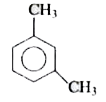An organic compound A(C4H9Cl) on the reaction with Na/diethly ether gives a hydrocarbon which on monochlorination gives only one chloro derivative then, A is
t-butyl chloride
Secondary butyl chloride
Isobutyl chloride
n-butyl chloride
The correct Answer is:A
To solve the problem, we need to identify the organic compound A (C₄H₉Cl) that reacts with sodium in diethyl ether to yield a hydrocarbon, which upon monochlorination gives only one chloro derivative. Let's break it down step by step.
Step 1: Analyze the molecular formula
The given molecular formula is C₄H₉Cl. This indicates that the compound contains 4 carbon atoms, 9 hydrogen atoms, and 1 chlorine atom.
Hint: Look for common structures that fit this molecular formula, particularly those that might lead to a single product upon monochlorination.
Step 2: Identify possible structures
Considering the structure of C₄H₉Cl, we can think of different isomers. The most likely candidate that fits this formula and can lead to a single product upon chlorination is tertiary butyl chloride (C(CH₃)₃Cl), also known as 2-chloro-2-methylpropane.
Hint: Consider the branching in the carbon chain; branched structures often lead to fewer products upon chlorination.
Step 3: Reaction with sodium in diethyl ether
When tertiary butyl chloride reacts with sodium in diethyl ether, it undergoes the Wurtz reaction. This reaction typically leads to the formation of alkanes by coupling two alkyl halides. In this case, the product would be 2,2-dimethylpropane (C₅H₁₂).
Hint: Remember that Wurtz reaction involves the coupling of alkyl halides, which can lead to the formation of larger alkanes.
Step 4: Monochlorination of the hydrocarbon
The hydrocarbon formed (2,2-dimethylpropane) can undergo monochlorination. Since all the hydrogen atoms on the same carbon are equivalent, replacing any of these hydrogen atoms with chlorine will yield the same product. Therefore, only one chloro derivative will be formed, which is 1-chloro-2,2-dimethylpropane.
Hint: Monochlorination leads to only one product when all the hydrogen atoms being replaced are equivalent.
Conclusion
Based on the analysis, the compound A (C₄H₉Cl) is tertiary butyl chloride (C(CH₃)₃Cl).
Final Answer: The compound A is tertiary butyl chloride.
---
The given molecular formula is C₄H₉Cl. This indicates that the compound contains 4 carbon atoms, 9 hydrogen atoms, and 1 chlorine atom.
Considering the structure of C₄H₉Cl, we can think of different isomers. The most likely candidate that fits this formula and can lead to a single product upon chlorination is tertiary butyl chloride (C(CH₃)₃Cl), also known as 2-chloro-2-methylpropane.
When tertiary butyl chloride reacts with sodium in diethyl ether, it undergoes the Wurtz reaction. This reaction typically leads to the formation of alkanes by coupling two alkyl halides. In this case, the product would be 2,2-dimethylpropane (C₅H₁₂).
The hydrocarbon formed (2,2-dimethylpropane) can undergo monochlorination. Since all the hydrogen atoms on the same carbon are equivalent, replacing any of these hydrogen atoms with chlorine will yield the same product. Therefore, only one chloro derivative will be formed, which is 1-chloro-2,2-dimethylpropane.
Based on the analysis, the compound A (C₄H₉Cl) is tertiary butyl chloride (C(CH₃)₃Cl).
Topper's Solved these Questions
- HALOALKANES AND HALOARENES BOOK - AAKASH INSTITUTE ENGLISHCHAPTER - HALOALKANES AND HALOARENES EXERCISE - ASSIGNMENT SECTION -D
15 Videos
- HALOALKANES AND HALOARENES BOOK - AAKASH INSTITUTE ENGLISHCHAPTER - HALOALKANES AND HALOARENES EXERCISE - ASSIGNMENT SECTION - B
25 Videos
- GENERAL PRINCIPLES AND PROCESSES OF ISOLATION OF ELEMENTSBOOK - AAKASH INSTITUTE ENGLISHCHAPTER - GENERAL PRINCIPLES AND PROCESSES OF ISOLATION OF ELEMENTSEXERCISE - Try Yourself
33 Videos
- HYDROCARBONSBOOK - AAKASH INSTITUTE ENGLISHCHAPTER - HYDROCARBONSEXERCISE - Assignment(Section - C) (Previous Years Questions)
60 Videos
Similar Questions
An organic compound A(C4H6CI) on reation withNa/diethyl ether gives a hydrocarbon which on monochlorination gives only one chloro derivative A is .
View SolutionAn organic compound (A) C4H9Cl on reacting with aqueous KOH gives (B) and on reaction with alcoholic KOH gives (C ), which is also formed on passing the vapours of (B) over the heated copper. The compound (C ) readily decolourises bromine water. Ozonolysis of (C ) gives two compounds (D) and (E ). Compound (D) reacts with NH2OH to give (F) and compound (E ) reacts with NaOH to have an alcohol (G) and sodium salt (H) of an acid. (D) can also be prepared form propyne on treatment with water in the presence of Hg2+ and H2SO4. Identify (A) to (H) with proper reasoning.
View Solution
Knowledge Check
Which one of the following compounds give only one isomer upon nitration ?
A B
B C
C D
D
An organic compound C4H6 on reductive ozonolysis gives HCHO,CO2andCO3CHO. Find structure of compound.
AH2C=CH−CH=CH2BCH3−CH=C=CH2C DH3C−C≡C−CH3
DH3C−C≡C−CH3
A hydrocarbon with formula C8H18 gives one monochloro derivative. The hydrocarbon can be:
View SolutionAn aromatic compound (A),C8H10, on oxidation with acidic KMnO4 gives dibasic acid. The compound (A) on nitration gives three isomeric nitro derivatives. The compound (A) is:
View SolutionA compound P(C5H6) gives positive Bayer test and on hydrogentation from a hydrocarbon B(C5H10) which gives only monochloro product. The compound 'P' is.
View SolutionAn organic compound X(C4H8O2) gives positive test with NaOH and Phenopthalein. Structure of X will be:
View SolutionAn organic compound (A) (C6H10O) on reaction with CH3MgBr followed by acid treatment gives compound (B). The compound (B) on ozonolysis gives compound (C ), which in the presence of a base gives 1-acetyl cyclopentene (D). The compound (B) on reaction with HBr gives compound (E ). Write the structures of (A), (B), (C ), (D), and (E ). Show how (D) is formed from (C ).
View SolutionA compound (C5H8) gives with ppt. with ammonical AgNO3 and on reduction followed by monochlorination it gives 4 structrual monochloro products. What is the possible structure of compound ?
View Solution
